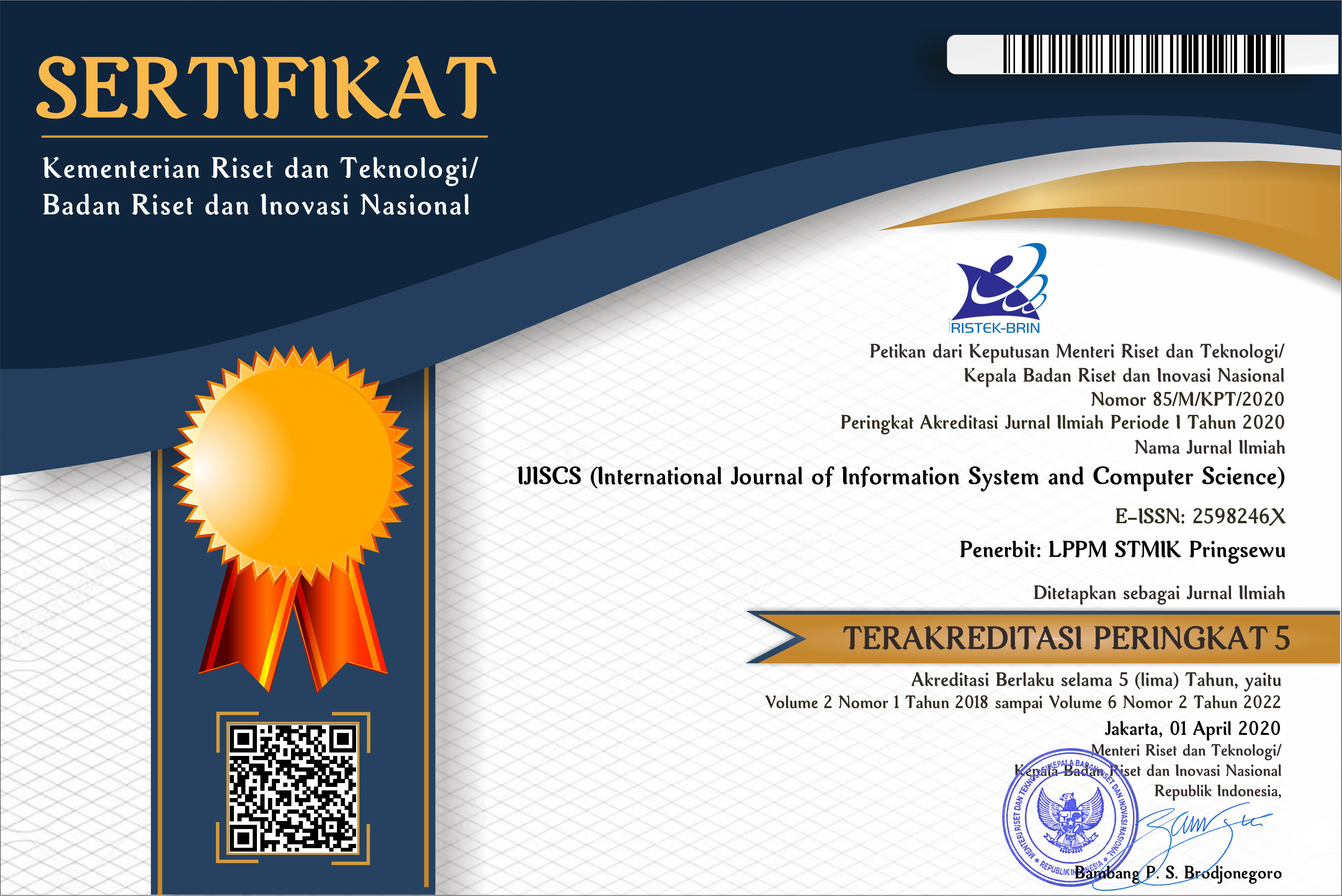DESIGNING A MOBILE APPLICATION TO MANAGE AND REDUCE COMMON MENTAL HEALTH PROBLEMS DURING THE COVID-19 PANDEMIC
(1) Department of Information System, Widyatama University, Bandung City, West Java
(2) Department of Information System, Widyatama University, Bandung City, West Java
 Corresponding Author
Corresponding Author
Abstract
Alongside the expanding dispersal of data on the number of instances of death because of the Coronavirus outbreak, a large part of the data introduced by the media unveils the more stressed and causes a mental effect, in particular a psychological problem that causes a psychosomatic issue. The plan of this application is to assist individuals with overseeing and lessen sensations of stress or sadness in overabundance by doing contemplation that should be possible even at home and to expand the utilization of the application, the gamification technique is utilized to inspire clients to seek after existing objectives and structure new schedules for the client to rehash the action until the new propensity is shaped. The aftereffects of the assessment utilizing the ease of use testing imply that they are at a moderate level dependent on the principle markers. Along these lines, it tends to be reasoned that the plan of the arrangement gives a positive discernment as far as client experience and convenience.
Keywords
References
V. Harrison, J. Proudfoot, P. P. Wee, G. Parker, D. H. Pavlovic, and V. Manicavasagar, “Mobile mental health: Review of the emerging field and proof of concept study,” J. Ment. Heal., vol. 20, no. 6, pp. 509–524, 2011, doi: 10.3109/09638237.2011.608746.
J. Firth and J. Torous, “Smartphone apps for schizophrenia: A systematic review,” JMIR mHealth uHealth, vol. 3, no. 4, pp. 1–9, 2015, doi: 10.2196/mhealth.4930.
G. Doherty, D. Coyle, and M. Matthews, “Design and evaluation guidelines for mental health technologies,” Interact. Comput., vol. 22, no. 4, pp. 243–252, 2010, doi: 10.1016/j.intcom.2010.02.006.
N. F. Bindhim, A. Hawkey, and L. Trevena, “A systematic review of quality assessment methods for smartphone health apps,” Telemed. e-Health, vol. 21, no. 2, pp. 97–104, 2015, doi: 10.1089/tmj.2014.0088.
S. M. Schueller, J. J. Washburn, and M. Price, “Exploring mental health providers’ interest in using web and mobile-based tools in their practices,” Internet Interv., vol. 4, no. June, pp. 145–151, 2016, doi: 10.1016/j.invent.2016.06.004.
J. Torous et al., “Utilizing a Personal Smartphone Custom App to Assess the Patient Health Questionnaire-9 (PHQ-9) Depressive Symptoms in Patients With Major Depressive Disorder,” JMIR Ment. Heal., vol. 2, no. 1, p. e8, 2015, doi: 10.2196/mental.3889.
S. R. Stoyanov, L. Hides, D. J. Kavanagh, O. Zelenko, D. Tjondronegoro, and M. Mani, “Mobile app rating scale: A new tool for assessing the quality of health mobile apps,” JMIR mHealth uHealth, vol. 3, no. 1, 2015, doi: 10.2196/mhealth.3422.
J. Goodwin, J. Cummins, L. Behan, and S. M. O’Brien, “Development of a mental health smartphone app: perspectives of mental health service users,” J. Ment. Heal., vol. 25, no. 5, pp. 434–440, 2016, doi: 10.3109/09638237.2015.1124392.
P. A. Arean et al., “The use and effectiveness of mobile apps for depression: Results from a fully remote clinical trial,” J. Med. Internet Res., vol. 18, no. 12, 2016, doi: 10.2196/jmir.6482.
J. E. Bardram, M. Frost, K. Szántó, M. Faurholt-Jepsen, M. Vinberg, and L. V. Kessing, “Designing mobile health technology for bipolar disorder: A field trial of the MONARCA system,” Conf. Hum. Factors Comput. Syst. - Proc., pp. 2627–2636, 2013, doi: 10.1145/2470654.2481364.
Www.teenmentalhealth.org, “Mental Health & High School Curriculum Guide,” no. March, pp. 1–165, 2017.
Aisha Salman, “Investing in M E N TA L H E A LT H,” Invest. Ment. Heal., p. 342, 2012.
D. Crone-Grant and T. Grant, “Physical activity and mental health,” A Life Day, vol. 4, no. 4, pp. 11–14, 2000, doi: 10.1108/13666282200000029.
S. W. Ha and J. Kim, “Designing a Scalable, Accessible, and Effective Mobile App Based Solution for Common Mental Health Problems,” Int. J. Hum. Comput. Interact., vol. 36, no. 14, pp. 1354–1367, 2020, doi: 10.1080/10447318.2020.1750792.
P. Azad-Khaneghah, N. Neubauer, A. Miguel Cruz, and L. Liu, “Mobile health app usability and quality rating scales: a systematic review,” Disabil. Rehabil. Assist. Technol., vol. 0, no. 0, pp. 1–10, 2020, doi: 10.1080/17483107.2019.1701103.
D. Bakker, N. Kazantzis, D. Rickwood, and N. Rickard, “Mental Health Smartphone Apps: Review and Evidence-Based Recommendations for Future Developments,” JMIR Ment. Heal., vol. 3, no. 1, p. e7, 2016, doi: 10.2196/mental.4984.
M. Olff, “Mobile mental health: A challenging research agenda,” Eur. J. Psychotraumatol., vol. 6, no. July, 2015, doi: 10.3402/ejpt.v6.27882.
J. M. C. Bastien, “Usability testing: a review of some methodological and technical aspects of the method,” Int. J. Med. Inform., vol. 79, no. 4, pp. e18–e23, 2010, doi: 10.1016/j.ijmedinf.2008.12.004.
R. S. Weinberg, “Prototyping and the systems development life cycle,” J. Inf. Syst. Manag., vol. 8, no. 2, pp. 47–53, 1991, doi: 10.1080/07399019108964983.
“IDEO Design Thinking | IDEO | Design Thinking.” https://designthinking.ideo.com/ (accessed Dec. 13, 2020).
“Making Energy Personal Through Design Thinking | Stanford Energy Journal.” https://sej.stanford.edu/making-energy-personal-through-design-thinking (accessed Dec. 15, 2020).
natassa r Tejena and luh made karisma Sukmayanti, “MEDITASI MENINGKATKAN REGULASI EMOSI PADA REMAJA Natassa R . Tejena dan Luh Made Karisma Sukmayanti,” Psikol. Udayana, vol. 05, pp. 147–158, 2018.
Article Metrics
Abstract View : 325 times
: 325 times Download : 105 times
Download : 105 times
DOI: 10.56327/ijiscs.v5i1.991
Refbacks
- There are currently no refbacks.






